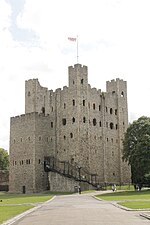Rochester Castle stands on the east bank of the River Medway in Rochester, Kent, South East England. The 12th-century keep or stone tower, which is the castle's most prominent feature, is one of the best preserved in England or France.
Situated on the River Medway and Watling Street, Rochester was a strategically important royal castle. During the late medieval period it helped protect England's south-east coast from invasion. The first castle at Rochester was founded in the aftermath of the Norman Conquest. It was given to Bishop Odo, probably by his half-brother William the Conqueror. During the Rebellion of 1088 over the succession to the English throne, Odo supported Robert Curthose, the Conqueror's eldest son, against William Rufus. It was during this conflict that the castle first saw military action; the city and castle were besieged after Odo made Rochester a headquarters for the rebellion. After the garrison capitulated, this first castle was abandoned.
Between 1087 and 1089, Rufus asked Gundulf, Bishop of Rochester, to build a new stone castle at Rochester. He established the current extent of the castle. Though much altered through the centuries, some parts of Gundulf's work survive. In 1127 King Henry I granted the castle to the Archbishop of Canterbury in perpetuity. William de Corbeil built the massive keep that still dominates the castle today. Throughout the 12th century the castle remained in the custody of the archbishops.
During the First Barons' War (1215–1217) in King John's reign, baronial forces captured the castle from Archbishop Stephen Langton and held it against the king, who then besieged it. The Barnwell chronicler remarked "Our age has not known a siege so hard pressed nor so strongly resisted". After resisting for just over seven weeks, the garrison surrendered. The castle had been greatly damaged, with breaches in the outer walls and one corner of the keep collapsed, and hunger eventually forced the defenders' hand. The castle did not stay under John's control for long: in 1216 it was captured by the French Prince Louis, who was the new leader of the baronial faction. John died and was succeeded by his son King Henry III in 1216; the next year, the war ended and the castle was taken under direct royal control.
Rochester was besieged for the third time in 1264 during the Second Barons' War (1264–1267). The castle's royal constable, Roger de Leybourne, held Rochester in support of Henry III. Rebel armies led by Simon de Montfort and Gilbert de Clare entered the city and set about trying to capture the castle. Again the castle's defenders resisted, this time with a different outcome. After a week, the rebel armies raised the siege in the face of relief from Henry himself. The garrison did not surrender, and the castle suffered extensive damage that was not repaired until the following century. The castle saw military action for the last time in 1381 when it was captured and ransacked during the Peasants' Revolt. As Rochester Castle fell out of use its materials were reused elsewhere and custodianship relinquished by the Crown. The castle and its grounds were opened to the public in the 1870s as a park. At various points during the 19th and 20th centuries repairs were carried out. The castle is protected as a Grade I listed building and Scheduled Monument. Today the ruins are in the guardianship of English Heritage and open to the public.










